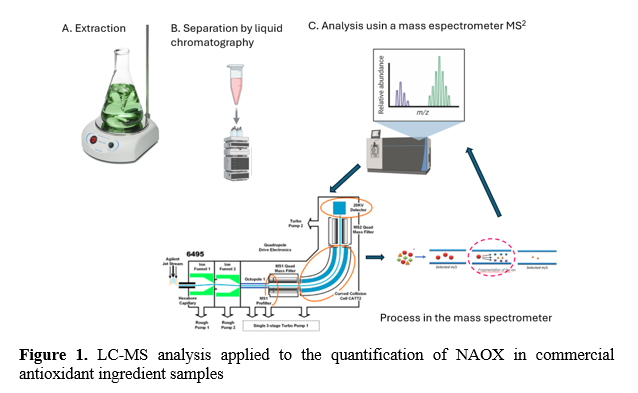ADVANCES IN THE QUANTIFICATION OF NATURAL ANTIOXIDANTS (NAOX) IN FISH FEED INGREDIENTS BY LC-MS AND CORRELATION WITH ANTIOXIDANT ACTIVITY
Introduction
Oxidative stress is a widespread condition generated by various environmental and farming practices. leading to poor fish health and quality issues. Insufficient dietary antioxidants to alleviate oxidative stress have generated the need for more natural alternatives, and several promising natural antioxidants (NAOX) have been identified. For their successful application in aquaculture, one critical factor is the use of reliable and accurate methods for NAOX quantification in the production chain, that allow a better study of the ir effects, more controlled processes , and higher reproducib ility in the production conditions. Liquid chromatography mass spectrometry (LCMS) is commonly used for analysing from few to over hundreds NAOX in diverse types of samples. However, aspects such as the stability of the compounds and matrix effects are often ignored although they can have an important impact on the accuracy of the results. Thus, in this work, we implemented a LC/MS method for accurate and reliable quantification of NAOX in a commercial antioxidant ingredient containing natural sources commonly used.
Materials and Methods
Three commercial samples of antioxidant ingredients for fish feed, containing a mixture of NAOX, were supplied by Arctic Feed Ingredients (AFI, Steinskjer, Norway). An accurate and reliable method by LC-MS illustrated in Figure 1. was implemented for quantification of the main NAOX. The comprehensive study included; 1) the evaluation of di fferent solvents for extraction of the NAOX from the samples, 2) optimization of the instrumental parameters for the collision cell in mass spectrometry, and 3) stability studies of the NAOX in the selected solvent individually and in groups. For the latter , the stability was measured as the change of the LC-MS signals of the polyphenols in terms of their storage time (0, 1, 6, and 9 days), temperature (4, − 20, and − 80 ◦C), vial colour (transparent, amber), and concentration (0.1 and 30 µg/mL). The analytical method was validated for selectivity, linearity, detection, and quantification limits (LOD and LOQ) and additionally, a comprehensive study of matrix effects was included . As evaluation of the antioxidant capacity, CUPRAC and DPPH methods were used.
Results and discussion
Methanol showed the global best performance for extraction for all the selected compounds in the evaluated solvent. Regarding stability of the LC-MS signal of the NAOX, no consistent effect was observed for the storage of the solutions at different temperatures, or the different vials, but in contrast, time of storage was found to affect the signal obtained. In general, a reduction of the signals was observed for 3 out of 6 NAOX. T he worst stability was found for 2 NAOX , for which even 1 day post preparation, changes were more noticeable than for the other compounds. Stability improved with higher concentrations of the NAOX.
For the validation parameters, evaluation of the extracted ion chromatograms demonstrated that LC -MS/MS can determine the selected NAOX without interference from other components in the sample. The matrix effect, evaluated not in a single point but by comparison of the slopes of external standard and standard addition calibrations for each compound, was negligible for 3 out of 6 compounds . However, significant matrix effects were observed in the other 3 . For instance, the ratio of the standard addition to external standard slope for 2 NAOX showed enhanced sensitivity of 3.84 and 1.93, respectively. In contrast, the same relationship for a 3rd one was 0.47, indicating a significant signal suppression of the sample matrix on the analytical signal. Considering the important matrix effects found, the linearity was assessed by using standard addition calibrations by coefficient of regression (r2) and a lack of fit test using the experimental Fisher test for the 6 compounds. The six models were used to evaluate LOD, LOQ, and method accuracy by introducing the experimental signals back into the calibration model to determine the estimated concentration in relation to the nominal value. The accuracy for the six polyphenols was within the ± 15 % interval of variation suggested by the ICH and regarded as acceptable for the determination of polyphenols in fish feed ingredients.
The antioxidant activity was evaluated by 2 different methods, CUPRAC and DPPH. The total content of polyphenols quantified in the samples did not show a direct correlation with the antioxidant capacity. Possible explanations are the different potency of individual compounds and/or the presence of NAOX not quantified.
Conclusion
To the authors knowledge, this is the first report on the validation of a LC-MS/MS method for quantifying selected polyphenols in commercial fish feed ingredients, supplemented with polyphenols from plant extracts using the standard addition method. The study highlighted the importance of performing a prior evaluation of the stability and matrix effects to decide the correct calibration strategy. The method showed adequate performance and demonstrated to be adequate for the accurate quantification of NAOX in industrial samples in aquaculture. The complementary study of antioxidant capacity showed that both approaches are complementary and important to product applications and standardizations.
REFERENCE
(1) Sarmiento, V.; Hamre, K.; Arnø, A.; Dagogo, J.; Ødegård, E.; Elvebø, O.; Araujo, P. Stability Study and Validation of a Liquid Chromatography Tandem Mass Spectrometry Method for the Quantitative Analysis of Polyphenols in Fish Feed Ingredients. J. Chromatogr. B 2024, 1238, 124108. https://doi.org/10.1016/j.jchromb.2024.124108.
